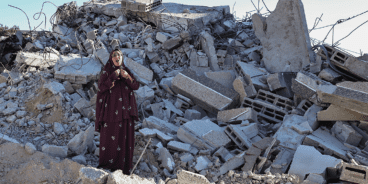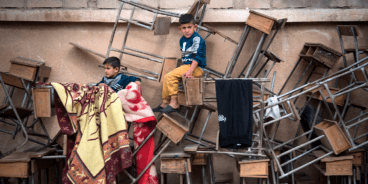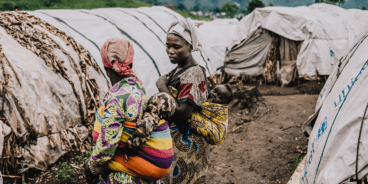
Sudan at a Critical Juncture
On 9 September 2010 the Global Centre for the Responsibility to Protect will hold a panel discussion on Sudan. The meeting will draw on the findings of the first Global Centre for the Responsibility to Protect Occasional Paper entitled, “Unwilling and Unable: The Failed Response to the Atrocities in Darfur,” written by James Traub. The panel will consider past failures and what needs to be done, by whom, to prevent a return to mass atrocities in Sudan.
This discussion is timely as the country today stands at a precipice with escalating atrocities and return to all out war in the South a possibility. Intertribal violence is rising in the South, as is the death toll from conflict in Darfur. A history of mass atrocities, massive internal displacement, the inability and unwillingness of domestic actors to provide sufficient physical protection, and insufficient preparation for the 9 January 2011 referendum in which voters in the South will decide whether to secede from the North, raise the potential for atrocities.
As a signatory of the 2005 World Summit Outcome Document, the Government of Sudan (GoS) committed, along with every other UN member state, to protect their populations from genocide, war crimes, ethnic cleansing and crimes against humanity. The GoS continues to fail to uphold this responsibility to protect (R2P). As a result, UN member states, in keeping with their own commitment to R2P have a responsibility, at this critical juncture, to act to prevent atrocities before the situation deteriorates further. Such international engagement must include placing pressure on the GoS, as well as the Government of South Sudan (GoSS) to exercise their responsibility to protect but pressure alone is insufficient. Additional policy responses must be developed, and existing measures strengthened to better address the security situation throughout the country.
Current Risks
In 2005 the GoS and the Sudan People’s Liberation Movement/Army (SPLM/A) signed the Comprehensive Peace Agreement (CPA), ending the country’s decades long civil war. Pursuant to the CPA, the South Sudanese are scheduled to vote in a referendum on independence. A vote in favor of division is expected. Many, including former United States director of intelligence Denis Blair, have warned “that the risk of renewed conflict [in the South] is rising as we approach 2011,” and the referendum.
The likelihood of atrocities is exacerbated by inter-ethnic violence over access to resources (including cattle), the proliferation of weapons, and divisions among political factions. 2,500 South Sudanese have already been killed and 350,000 people displaced in the past year. Tensions over the failure to implement key provisions of the CPA, including North/South border demarcation and a final agreement on oil revenue sharing between the North and South, may contribute to violence. Oil-rich Abyei, which will hold its own referendum to determine if it wishes to join the South, or remain in the North with “special administrative status,” faces its own risks with armies from the North and South already gathering on its borders. The question of residency requirements for participation in the Abyei referendum has not yet been answered and remains a dangerous issue with tension high between farmers living as permanent residents in the Abyei area and pastoralists seeking to maintain grazing rights in the region. Similarly, little progress has been made on the popular consultations in the border regions of Southern Kordofan and Blue Nile, called for in the CPA to determine the “will of the people” and to serve as a starting point for a possible decentralization of government.
International engagement post-referendum is imperative as the risk of atrocities will remain, if not increase. An escalation in inter-tribal violence and a resort to armed conflict between opposing political movements within the South are real possibilities. SPLA abuses of civilians in areas of opposition political support are already being seen. The potential for escalation, possibly into a civil war is enhanced because the GoSS currently lacks the ability to address rising insecurity. Additionally, the risk of violence in the border areas of Abyei, Southern Kordofan and Blue Nile will likely remain significant in the post-referendum period. One final area of concern relates to the close to two million South Sudanese living in the North, and the smaller numbers of Northerners living in the South who may be forcibly displaced and become the targets of attacks. Adequate preparations for securing the protection and humanitarian needs of these potential populations have yet to be made.
The situation in Darfur is similarly dire with civilians continuing to endure the brunt of ongoing fighting between the GoS and rebel movements. Crimes are rising despite ongoing political negotiations in Doha, Qatar. In May 2010 alone 400 to 600 people were killed, more than in any period since 2008, with the areas of Jebel Marra and Jebel Moon hardest hit. Attacks on humanitarian workers and convoys, and on the African Union-United Nations Hybrid Operation in Darfur (UNAMID), continue. Ibrahim Gambari, the Joint African Union-United Nations Special Representative for Darfur, referenced in his 27 July Security Council briefing the “dire security situation in Darfur” and stated that UNAMID’s efforts were having little success in ameliorating the situation. The ongoing violence and chronic instability has resulted in over two million internally displaced persons (IDPs) living in IDP camps in Darfur, and several hundred thousand more refugees in camps in Chad, all of whom have scant prospect of returning home. Of particular concern in recent weeks is the crisis in Kalma Camp, the largest IDP camp in Darfur, where violence broke out between rebel movements supporting the Darfur peace process in Doha, and those opposed. Worryingly, in the wake of the violence, the GoS blocked humanitarian access to the camp.
Finally, the Ugandan based Lord’s Resistance Army (LRA) continues to commit war crimes and crimes against humanity in Central and Western Equatorial states, perpetrating numerous massacres, abductions, rapes and mutilations and sending thousands fleeing their villages. The Sudanese government is ill equipped to address this threat and has failed to take even those steps that it is capable of to protect its population from the LRA.
International Engagement
United Nations member states have attempted to exercise their responsibility to protect through the implementation of two peacekeeping missions in Sudan, UNMIS (United Nations Mission in the Sudan) in the South and UNAMID in Darfur. Both missions have broad civilian protection mandates, but they lack sufficient resources and guidance on how to carry out these mandates. In some cases troop contributing countries are reluctant to deploy troops to more dangerous locations and thus lack the flexibility in their terms of engagement to ensure that the protection of civilians aspect of the mandates are fulfilled. Additionally attacks on UN personnel and restrictions on movement put in place by the GoS are also hampering the missions’ ability to deploy troops preventatively in all areas where there is a risk of violence. Difficulty in gathering early warning information about potential risks and identifying possible perpetrators limits the missions’ ability to do the analysis needed to initiate an early response. Not surprisingly, developing contingency plans becomes more challenging in such an environment as does developing strategies based on a determination of what the incentives for perpetrating crimes are, and what levers can be used to change the calculus for committing atrocities.
More needs to be done by international actors to uphold their responsibility to protect populations in Sudan. A coordinated strategy for international engagement that addresses threats throughout the country must be developed. The piecemeal approach, focusing on one region, at the expense of others, cannot continue. In 2004/5 clear warning signs of atrocities in Darfur were overlooked in an attempt to secure, through the CPA, a settlement to the decades long brutal civil war in the South. Similarly, once concerns about genocide in Darfur became paramount, international efforts to ensure the successful implementation of the CPA were neglected. International actors cannot risk making the same mistakes and find that they have yet again failed to protect the people of Sudan.
Conclusion
Given the grave risk of mass atrocities and the Government of Sudan’s manifest failure to protect its population, it is clear that UN member states have a responsibility to protect the people of Sudan. The key question remains: what needs to be done to prevent a return to large scale atrocities?
Possible recommendations include the need to take steps to strengthen the capacity of the GoSS, the creation of contingency plans by UNAMID and UNMIS to deal with the potential for increasing violence, the expansion of the peacekeeping missions’ presence on the ground and the adoption of a coordinated approach by the Security Council to deter potential perpetrators from committing crimes. The panel discussion “Sudan at a Critical Juncture” seeks to examine these recommendations and propose possible measures that can be implemented, as well as determine which actors are best placed to take action.
Related Content


